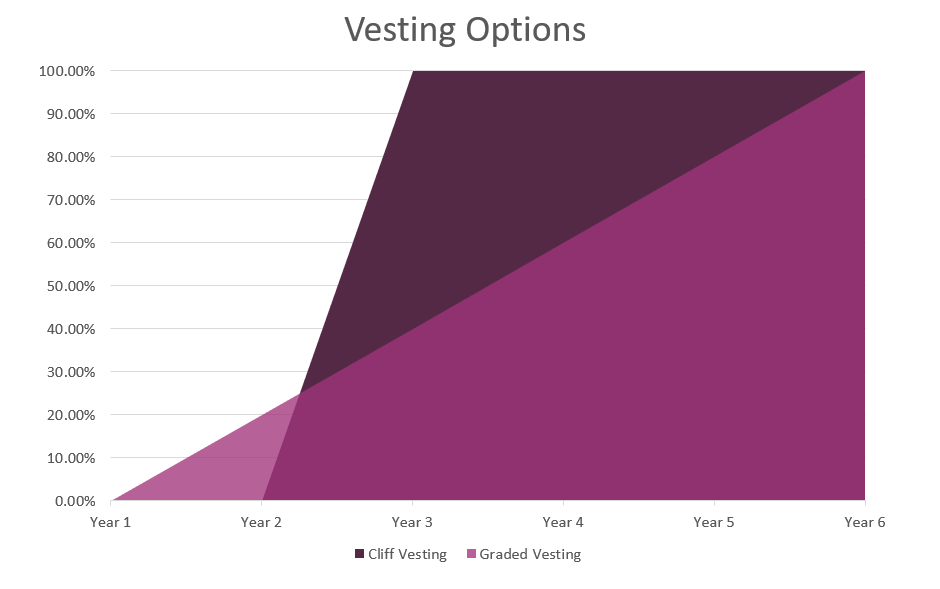Changing jobs comes with many considerations, including weighing benefits, potential relocation, and what to do with retirement benefits, such as a 401(k) or 403(b) account, tied to your job. This article outlines options to consider for your 401(k), actions to take (and not take), and reasons for you to choose one path or another.
What Do I Get From My 401(k) Plan When I Leave?
If you leave your job, whether by choice or not, you are entitled to your vested balance in your 401(k) account. Usually your vested 401(k) balance includes:
- Your pre-tax, after-tax, and Roth contributions
- Any investment earnings
- Employer contributions and earnings that satisfied your plan's vesting schedule
Vesting in a 401(k) plan refers to the part that you own, which often grows over the length of your employment. Generally speaking, you must be 100% vested in your employer's contributions after three years of employment ("cliff vesting"), or you must vest gradually, 20% per year until you're fully vested after six years ("graded vesting"). Some plans have faster vesting schedules, and with some 401(k) plans you’re immediately 100% vested. When you reach retirement age, you'll also be 100% vested.

When you leave your job, you’ll forfeit any employer contributions that haven’t vested already, so make sure to understand your employer’s 401(k) vesting schedule before you leave your job voluntarily. If you don’t have access to that information, ask your plan administrator for it – it should be included in the summary plan description. For instance, if you’re about to reach a fully vested stage, you’ll want to wait until that happens, if possible, to own as much of your 401(k) holdings as you can.
Refrain From Spending Your 401(k) Fund
A tidy sum within reach does look attractive, but it’s important to keep it intact if you possibly can. Taking a distribution likely means you'll be taxed, at ordinary income tax rates, on the entire value of your account except for any after-tax or Roth 401(k) contributions you've made. Also, if you haven’t reached age 55, you also might owe an extra 10% penalty on the taxable portion. (Make sure to check on lump-sum distribution rules if your 401(k) includes employer stock.)
If you have more than $7,000 in your vested balance, you can leave it in your employer's plan until you reach age 65, which is often the retirement age specified in 401(k) plans. You also have the option to make a direct rollover to an IRA or to another employer's 401(k) plan. When you initiate a direct rollover, your vested balance passes directly from your 401(k) plan account to the new account. Choose a direct rollover rather than a "60-day rollover," which means you get a check and roll the balance over yourself and your employer withholds 20% of the taxable portion. With a 60-day rollover, you can roll over the entire amount, but you need to come up with the 20% being withheld until you get it back when you file your income tax return.
Rolling Over To A New Employer’s 401(k) Or An IRA
If you have the option to roll the funds over into a new 401(k) or IRA, there are benefits of both options, so consider them and make the best choice for your situation. You’ll want to consult an expert because this decision can have significant consequences — now and in the future.
Benefits to consider rolling over to an IRA: 
- You generally have more investment choices with an IRA than with an employer's 401(k) plan. You typically may freely move your money around to the various investments offered by your IRA trustee, and you may divide up your balance among as many of those investments as you want. By contrast, employer-sponsored plans generally offer a limited menu of investments (usually mutual funds) from which to choose.
- You can freely allocate your IRA dollars among different IRA trustees/custodians. There's no limit on how many direct, trustee-to-trustee IRA transfers you can do in a year. This gives you flexibility to change trustees often if you are dissatisfied with investment performance or customer service. It can also allow you to have IRA accounts with more than one institution for added diversification. With an employer's plan, you can't move the funds to a different trustee unless you leave your job and roll over the funds.
- An IRA may give you more flexibility with distributions. Your distribution options in a 401(k) plan depend on the terms of that particular plan, and your options may be limited. However, with an IRA, the timing and amount of distributions are generally at your discretion (until you reach age 73 and must start taking required minimum distributions in the case of a traditional IRA).
- You can roll over (essentially "convert") your 401(k) plan distribution to a Roth IRA. You'll generally have to pay taxes on the amount you roll over (minus any after-tax contributions you've made), but any qualified distributions from the Roth IRA in the future will be tax free. When considering if it is wise to convert these funds, you should take into account your income and current tax bracket.
Reasons to consider rolling over to your new employer's 401(k) plan (or stay in your current plan):
 Many employer-sponsored plans have loan provisions. If you roll over your retirement funds to a new employer's plan that permits loans, you may be able to borrow up to 50% of the amount you roll over if you need the money. You can't borrow from an IRA — you can only access the money in an IRA by taking a distribution, which may be subject to income tax and penalties. (You can give yourself a short-term loan from an IRA by taking a distribution, and then rolling the dollars back to an IRA within 60 days; however, this move is permitted only once in any 12-month time period.)
Many employer-sponsored plans have loan provisions. If you roll over your retirement funds to a new employer's plan that permits loans, you may be able to borrow up to 50% of the amount you roll over if you need the money. You can't borrow from an IRA — you can only access the money in an IRA by taking a distribution, which may be subject to income tax and penalties. (You can give yourself a short-term loan from an IRA by taking a distribution, and then rolling the dollars back to an IRA within 60 days; however, this move is permitted only once in any 12-month time period.)- Employer retirement plans generally provide greater creditor protection than IRAs. Most 401(k) plans receive unlimited protection from your creditors under federal law. Your creditors (with certain exceptions) cannot attach your plan funds to satisfy any of your debts and obligations, regardless of whether you've declared bankruptcy. In contrast, any amounts you roll over to a traditional or Roth IRA are generally protected under federal law only if you declare bankruptcy. Any creditor protection your IRA may receive in cases outside of bankruptcy will generally depend on the laws of your particular state. If you are concerned about asset protection, be sure to seek the assistance of a qualified professional.
- You may be able to postpone required minimum distributions. For traditional IRAs, these distributions must begin by April 1 following the year you reach age 73.1 However, if you work past that age and are still participating in your employer's 401(k) plan, you can delay your first distribution from that plan until April 1 following the year of your retirement. (You also must own no more than 5% of the company.)
- If your distribution includes Roth 401(k) contributions and earnings, you can roll those amounts over to either a Roth IRA or your new employer's Roth 401(k) plan (if it accepts rollovers). If you roll the funds over to a Roth IRA, the Roth IRA holding period will determine when you can begin receiving tax-free qualified distributions from the IRA. So if you're establishing a Roth IRA for the first time, your Roth 401(k) dollars will be subject to a brand new five-year holding period. On the other hand, if you roll the dollars over to your new employer's Roth 401(k) plan, your existing five-year holding period will carry over to the new plan. This may enable you to receive tax-free qualified distributions sooner.
When evaluating whether to initiate a rollover always be sure to (1) ask about possible surrender charges that may be imposed by your employer plan, or new surrender charges that your IRA may impose, (2) compare investment fees and expenses charged by your IRA (and investment funds) with those charged by your employer plan (if any), and (3) understand any accumulated rights or guarantees that you may be giving up by transferring funds out of your employer plan.
What about outstanding plan loans?
In general, if you have an outstanding plan loan, you'll need to pay it back, or the outstanding balance will be taxed as if it had been distributed to you in cash. If you can't pay the loan back before you leave, you'll still have 60 days to roll over the amount that's been treated as a distribution to your IRA. Of course, you'll need to come up with the dollars from other sources.
In some cases, you have no choice — you need to use the funds. If so, try to minimize the tax impact. For example, if you have nontaxable after-tax contributions in your account, keep in mind that you can roll over just the taxable portion of your distribution and keep the nontaxable portion for yourself.
1If you reached age 73 in the 2023 calendar year, you will need to take an RMD by April 1, 2024. Subsequent RMDs are due on December 31st annually thereafter.
02/14/2024





